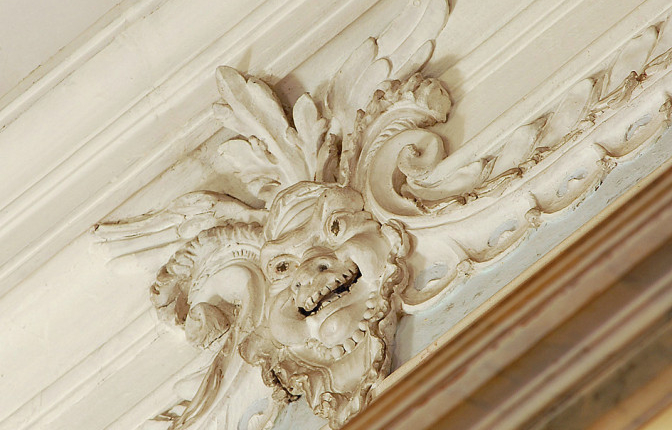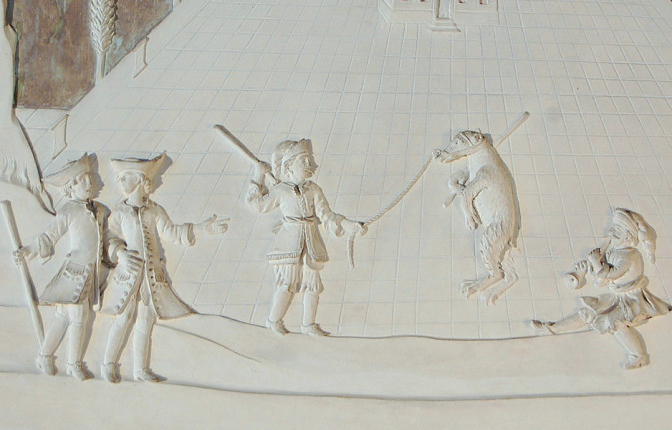Decorations of the Venetian Villas | Ca’ Marcello
The stucco works that decorate Ca’ Marcello are elegant presence in any room of the villa. They represent the most diverse subjects, from allegorical scenes to rural landscapes, through fanciful animals and ladies dressed with cute hats.
The Venetian stucco works
The Ca’ Marcello stuccos cycle dates back to the mid-eighteenth century, a period in which the frescoes were made in the ballroom on the Maruzzi family commission, the owner of the villa in that period.
Most of the rooms of the villa is enriched with plastic decorations depicting different subjects, some made from drawings by Giuseppe Zais: whims and landscapes, exotic and fantastic animals, ancient myths and masks. A colorful world that distinguishes the character of each room.
The noble floor is surely the one which houses the most elaborate and attractive stuccos. Here they have a major role in replacing the painted decorationsin in private rooms. They fram mirrors, doors, walls, and also create real bas-reliefs.
Ballroom
In the ballroom the frescoes stucco frames play an important role, surrounding the stories of Alexander the Great as a priceless paintings and creating an opening in the ceiling full of Olimpo’s Gods.
The walls are decorated with stucco-framed mirrors that have female heads on the top. Each frame is supported by illusion illusion ocher twisted of stucco that forms large flakes.
Some panels placed above the doors, happy cupids, carefree and fun grotesque masks placed on the entrances of the balcony, elegantly complete the decoration of this large room.
Fish-pond room
The room is dominated by three large stuccos frames, depicting allegorical personifications. The central frame houses Virtue fluctuating between fluffy clouds that looks towards Grace of God, a young woman who supports the cornucopia, indicating a bearded aging man, Merit.
The message of ths work surely regards the adventures of the villa owners: their wealth is given by the Grace of God, is based on the virtues and rewards merit.
Virtue is again the star of the second frame where she is crowned with the laurel of Fame and casts Envy, here masterfully represented as an old woman with snakes in her hair, in the act of biting his hands.
Virtue is always the leading figure of the last frame where she leads Hercules to immortality.
Mirror room
In this room, the decorations are animated by the play of different kinds of birds like parrots, storks and pelicans. There are also beautiful and buxom ladies, dragons and sphinxes. Here too there are pastoral landscapes that recall some aspects of life in the villa. The central mirror, from which the room is named, is made monumental by an elaborate stucco frame rich of spirals.
Master bedroom
Here there are pretty oval overdoor panel showing the Nobility, Liberality and Fertility. The walls are occupied by wide rural landscapes, inhabited by classical ruins, knights, exotic animals, musicians and farmers.
Summer room
In this room the stucco works remind bucolic environments and represent moments of leisure and rural life. Here can be feel a naif and fantastic dimension that combines local elements and oriental details.
The medallions with female busts remember that this room was used by noblewomen: each oval in fact contains a bust of a lady representing a particular hairstyle reserved for noble Venetian.
Visit the gardens and the main house
Essential bibliography
Monica De Vincenti, Simone Guerriero, Gli stucchi di Villa Maruzzi-Marcello a Levada di Piombino Dese, in L’arte dello stucco in Friuli nei secoli XVII-XVIIl. Storia, tecnica, interconnessioni, atti del convegno internazionale (Passariano-Udine 24-26 febbraio 2000), a cura di G. Bergamini, P. Goi, Udine 2001, pp. 187-198













